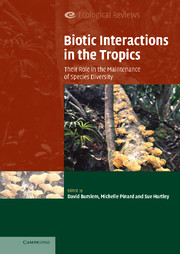Book contents
- Frontmatter
- Contents
- List of contributors
- Preface
- PART I Plant–plant interactions
- PART II Plant–microbe interactions
- PART III Plant–animal interactions
- PART IV Biotic interactions in human-dominated landscapes
- 18 The alteration of biotic interactions in fragmented tropical forests
- 19 Effects of natural enemies on tropical woody-plant invasions
- 20 New mix of alien and native species coexists in Puerto Rico's landscapes
- 21 The dynamics of a tropical dry forest in India: climate, fire, elephants and the evolution of life-history strategies
- 22 Changes in plant communities associated with timber management in natural forests in the moist tropics
- Index
- References
21 - The dynamics of a tropical dry forest in India: climate, fire, elephants and the evolution of life-history strategies
Published online by Cambridge University Press: 25 August 2009
- Frontmatter
- Contents
- List of contributors
- Preface
- PART I Plant–plant interactions
- PART II Plant–microbe interactions
- PART III Plant–animal interactions
- PART IV Biotic interactions in human-dominated landscapes
- 18 The alteration of biotic interactions in fragmented tropical forests
- 19 Effects of natural enemies on tropical woody-plant invasions
- 20 New mix of alien and native species coexists in Puerto Rico's landscapes
- 21 The dynamics of a tropical dry forest in India: climate, fire, elephants and the evolution of life-history strategies
- 22 Changes in plant communities associated with timber management in natural forests in the moist tropics
- Index
- References
Summary
Introduction
Tropical dry forests constitute over 40% of all tropical forests (Murphy & Lugo 1986), yet their dynamics have been poorly studied relative to tropical moist forests (Bullock et al. 1995). Major ecological factors influencing the dynamics of tropical dry forests include high variability in climate, herbivory by wild mammals and domestic livestock (Skarpe 1991; Sukumar et al. 1998), natural and human-induced fires (Swain 1992; Goldammer 1993) and human extraction of a variety of products (Chopra 1993; Narendran et al. 2001). There has been much thinking on the issue of stability of tropical forests; some of this follows from or is related to the broader issue of the stability–diversity debate (e.g. Connell 1978; Pimm 1984; Lawton 1994; Johnson et al. 1996) or that of the turnover rate of tropical forests (Philips et al. 1994; Sheil 1995). These have been discussed mostly in the context of tropical moist forests.
It is being increasingly recognized that environmental variability is a major influence in shaping the structure, functioning and evolution of communities. In particular, we can expect that environmental variability would influence the evolution of life-history traits of species that constitute a particular community (e.g. Murphy 1968; Gadgil & Bossert 1970; Stearns 1977, 1992; Boyce & Daley 1980). Interannual variation in climate (e.g. precipitation) is usually taken as the most important measure of environmental variability that shapes life-history traits in a species. At the same time, the role of disturbances (e.g. hurricanes, fire) in eliciting short-term ecological responses should also be considered.
- Type
- Chapter
- Information
- Biotic Interactions in the TropicsTheir Role in the Maintenance of Species Diversity, pp. 510 - 529Publisher: Cambridge University PressPrint publication year: 2005
References
- 20
- Cited by



